Chakra One: Earth, Physical identity, oriented
to self-preservation.
The lowest of the seven principal psychoenergetic
centers (chakras) of the body.This chakra is located at
the base of the spine and represents an unusually powerful
source of energy and power. The verb associated with this
chakra is "I have".
A yoga posture that helps to open the first
Chakra is SETUBANDHA ASANA or BRIDGE POSTURE. This posture
helps you to focus on the first chakra energy.
Lie on your back with the knees up and the arms
alongside the body. Your feet should be near your buttocks
about six inches apart.
While inhaling, gently raise your back and
lift the spine, trying to move one vertebra at a time
until your entire back is arched upward. Push firmly with
your feet. Keep your knees straight and close together.
Clasp your hands under your back and push against
the floor. Hold the inhaled breath and stay for a while.
Slowly exhale and relax on your back.
Other benefits: Increases flexibility
and suppleness; strengthens the lower back and abdominal
muscles; opens the chest.
CHAKRA TWO - SPLEEN CHAKRA
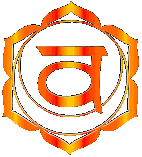 Name: Swadisthana
("Dwelling Place of the Self")
Name: Swadisthana
("Dwelling Place of the Self")
Location: Genitals
Human nature: Creativity
Color: Orange
Appearance: 6-leaf-lotus
Seed Syllable: "VAM"
Chakra Two: Water,
Emotional identity, oriented to self-gratification
The second chakra
is connected to the genitals and the bladder. This chakra
regulates and enhances the physical strength and the internal
energy of the body. If we are overly inclined towards
base pleasures we naturally waste much of our strength without
being able to gain it back. Our body then slowly weakens. On
the other hand, if we are wise enough to keep this life force
intact, this chakra will become highly developed. It will
direct this life force to the brain, thereby rendering
us more perceptive day by day. The verb that best describes
this chakra is "I feel".
A yoga posture that
helps to open the second Chakra is BHUJANGA ASANA or COBRA
POSTURE.
Bhujangasana - Cobra Posture
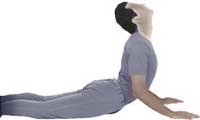
Lie on the stomach. Keep your legs together
with the arms alongside the body and your hands close
to your chest.
While inhaling, slowly raise your head and
chest as high as you can. Keep your buttocks muscles tight
to protect your lower back.
Now gently raise yourself on your arms stretching
the spine more and go as far as you are comfortable. Hold
the inhaled breath. Your pelvis should always remain on
the floor. Stay for a while.
Slowly exhale and return to the prone posture.
Other benefits: Stretches the spine,
strengthens the back and arms, helpful in bronchitis,
asthma and cervical spondylitis, reduces abdominal fat.
CHAKRA
THREE - SOLAR PLEXUS
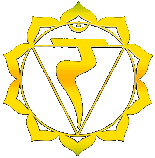 Name: Manipura
("City of Gems")
Name: Manipura
("City of Gems")
Location: Solar plexus
Human nature: Commitment
Color: Yellow Shadow
Appearance: 10-leaf-lotus
Seed Syllable: "RAM"
Chakra Three: Fire,
Ego identity, oriented to self-definition
The third chakra
is located on the spine at the level of the navel. It
is believed there is a triangular region of fire within this
chakra. It uses the energy contained in our daily food to nourish
our internal or life energy thus regulating the metabolism.
If this regulation is weak many visceral diseases develop
- particularly cancers. This chakra is also called the
'power Chakra' and represents personal power or willpower.
The verb associated with the third chakra is "I can".
The yoga posture
that helps to open the third chakra is DHANURA ASANA -
BOW POSTURE.
Dhanurasana - Bow Posture
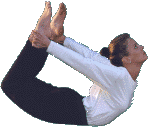
Lie on the stomach with the arms alongside the
body and the chin on the floor.
Exhale, bend the knees, reach back with the arms and
grasp the right ankle with the right hand and the left
ankle with the left hand.
While inhaling, slowly raise the legs by pulling the ankles
up and raising the knees off the floor while simultaneously
lifting the chest off the floor. Hold the inhaled breath.
The weight of the body should be resting on the abdomen.
Tilt the head as far back as possible. Hold the posture
as long as you can comfortably holding the inhaled breath.
Slowly exhale bringing the knees to the floor, release
the ankles, slowly bring the legs and arms straight down
on the floor and return to the prone posture.
Other benefits:
A good stimulating posture for the back and limbs, it
removes gastro-intestinal disorders, improves digestion and
helps in slimming the body and abdomen.
CHAKRA FOUR - HEART CHAKRA
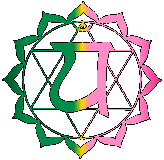 Name: Anahata
("Free from Constraint")
Name: Anahata
("Free from Constraint")
Location: Heart
Human nature: Compassion
Color: Green Shadow
Appearance: 12-leaf-lotus
Seed Syllable: "YAM"
Chakra Four: Air,
Social identity, oriented to self-acceptance
The fourth chakra
is located on the spine at the level of the heart. It
is also known as the "lotus of the heart". It pertains
to the soul - mercy, compassion, purity and nobility of soul,
absolute goodness, tolerance, forgiveness and the endless love
that embraces the universe. When this great vital point
is unblocked the chakra begins to spin at a very high
speed and all the cells in our body vibrate at such a
high frequency that we are able to express our love and
compassion to all people. If this chakra remains sealed
and does not function, although we may speak of mercy
our words will have no concrete effect. In the context
of energy transfers, this chakra is used in the treatment of
heart ailments and problems with blood. The verb that best describes
this chakra is "I love".
A yoga posture that
is excellent for opening the 4th chakra is USHTRA ASANA
- CAMEL POSTURE.
Ushtrasana - Camel Posture
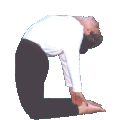
Sit up on the knees with the heels of the
feet pressed against the buttocks and the calves of the
legs flat on the floor.
Reaching backward, grasp the left ankle with the left
hand and right ankle with the right hand.
Inhale through the nostrils and lift the buttocks off
the legs arching the back and thrusting the abdomen forward
and tilt the head as far back as possible.
Either hold the posture for the duration of the inhaled
breath or breathe gently through the nostrils while holding
the posture.
Exhale and return to the kneeling position.
Other benefits: Makes the spine
flexible, increases blood-flow to the brain. Good for
back problems.
CHAKRA FIVE
- THROAT CHAKRA
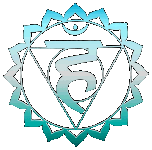 Name: Vishuddhi
("Pure")
Name: Vishuddhi
("Pure")
Location: Throat
Human nature: Truth
Color: Blue Shadow
Appearance: 16-leaf-lotus
Seed Syllable: "HAM">
Chakra Five: Sound,
Creative identity, oriented to self-expression
The fifth chakra
deals with the respiratory system, nose, lungs, throat
and skin. In fact it is connected to all those organs
that are in contact with air. It is located on the spine at
about the same level as the Adam's apple. This center is also
known as the 'great doorway to liberation'. This chakra is
related to communication and creativity. Here we experience
the world symbolically through vibration - such as the
vibration of sound representing language. The verb associated
with the fifth chakra is "I speak".
A yoga posture that
is excellent for opening the 5th chakra is MATSYA aSANA
- FISH POSTURE.
Matsyasana - Fish Posture

Lie flat on your back.
Keeping the buttocks on the floor, inhale and raise the
head, shoulders, back and upper arms off the floor arching
the back and raising the chest up. Tilt the head back
and place the top of the head flat on the floor.
Raise the elbows off the floor bring your hands up just
below the back and join them at the palms with the fingers
pointing straight up. Hold for the duration of the inhaled
breath or breathe gently through the nostrils to remain
in the posture longer.
Exhale and relax on your back.
Other benefits: Good for Diabetes and
Asthma patients and people with other lung diseases.
CHAKRA SIX - BROW CHAKRA
 Name:
Ajna ("Ausrerity")
Name:
Ajna ("Ausrerity")
Location: Between eyebrows
Human nature: Intuition
Color: Indigo
Appearance: 96-leaf-lotus(2x48)
Seed Syllable: "OM"
Chakra Six: Light, Archetypal
identity, oriented to self-reflection
The sixth chakra is
often referred to as the third or divine eye. It is located
in the middle of the forehead, about one centimeter above
the middle point of the eyebrows. The activation of this chakra
is said to lead to psychic powers called siddhi including clairvoyance
and telepathic communication. This center can be used in transferring
energy to any point in the universe thus overcoming the boundaries
of time and space. Someone with a well-developed sixth chakra
will be better able to listen to their intuition and connect
with the divine side of life and see the 'big picture'. The
verb associated with this chakra is "I see".
The yoga posture for
both 6th and 7th chakra is YOGA MUDRA.
Yoga
mudra
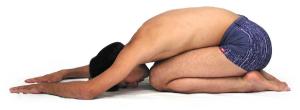
Sit on your knees.
Bend forward and touch
the floor with your forehead. Inhale and hold the breath.
Release the breath
and return.
Other benefits: Stimulates the nervous
system and strengthens the abdominal and pelvic muscles.
Also helps in improving digestion and relieving constipation.
CHAKRA SEVEN - CROWN CHAKRA
Chakra Seven: Thought,
Universal identity, oriented to self-knowledge.
The seventh chakra is
found at the top most point of the head. It is the chakra
that is used when there are problems with the nervous system.
This center is described as a white lotus in whose center
resides the Self. A well-developed seventh chakra is an indication
that someone has reached a very high level of spirituality. This
chakra relates to consciousness as pure awareness. It is our
connection to the greater world beyond - to a timeless, spaceless
place of all-knowing. When developed this chakra brings us
knowledge and wisdom and the experience is supreme bliss.
The verb that best describes this chakra is "I know".
The yogic path for seventh
chakra is MEDITATION.
Meditation is a yogic
process of providing deep rest to the system by allowing the
mind to calm down to its basal states.
With the discovery and
the opening of the seventh chakra, we transend from the physical
to something beyond....a greater consciousness. After all,
we are not our bodies, but our minds and souls. We are part
of the collective consciousness. We are part of the Great Spirit.
Top
Home
